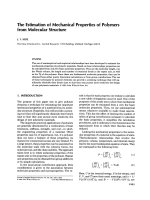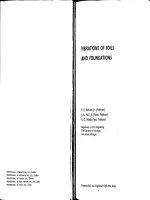Mechanical properties of polymers and composites-Nielsen Episode 1 doc
Bạn đang xem bản rút gọn của tài liệu. Xem và tải ngay bản đầy đủ của tài liệu tại đây (495.5 KB, 10 trang )
Library of Congress Cataloging-In-Publitation Date
Nielsen. Lawrence E.
Mechanical properties of polymers and composites / Lawrence E.
Nielsen. Robert F. Landel. — 2nd ed., rev. and expanded.
p. cm. — (Mechanical engineering ; 90)
Includes bibliographical references and index.
ISBN 0-8247-8964-4
1. Polymers—Mechanical properties. 2. Polymeric composites—
Mechanical properties. I. Landel. Robert F. II. Title.
III. Series: Mechanical engineering (Marcel Dekker) ; 90.
TA455.P58N48 1994
620.1 '9204292—dc20 93-38084
CIP
The publisher offers discounts on this book when ordered in bulk quan-
tities. For more information, write to Special Sales/Professional Marketing
at the address below.
This hook is printed on acid-free paper.
Copyright C 1994 by Marcel Dekker, Inc. All Rights Reserved.
Neither this book nor any part may he reproduced or transmitted in any
form or by any means, electronic or mechanical, including photocopying,
microfilming, and recording, or by any information storage and retrieval
system, without permission in writing from the publisher.
Current printing (last digit):
PRINTED IN THE UNITED STATES OF AMERICA
MECHANICAL
PROPERTIES
OF POLYMERS
AND
COMPOSITES
SECOND EDITION,REVISED AND EXPANDED
LAWRENCE E.NIELSEN
Monsanto Company
St. Louis. Missouri
F. LANDEL
Jet Propulsion Laboratory
California institute of Technology
Pasadena, California
Marcel Dekker, Inc. New York*Basel«Hong Kong
Contents
III. Stress or Strain Amplitude Effects 1S4
IV. Thermal History 137
V. Effect of MokcLil.ir Weight l&
VI. Effect of Cross-linking 1*7
VII. Effects of Crystallinity and Morphology H5
Vin. Effects of Plasticizcrs and Copolymerization 181
IX. Effect of Molecular Orientation 188
X. Effect of Strength of Intcrmolccular Forced 194
XL Polyblends, Block, and
#
Graft Polymers m
XH. Secondary Damping Peaks ' 282
Summary 212
Problems 3§|
Reference ^
Stress-Strain Behavior and Strength 3353
I. Stress-Strain Tests $3$
A. Introduction ^§
B. Models Hg$
C. T'orm of the stress—strain curve; Multiaxial
response |36
D. Comprcssioii and shear versus tensile tests:
Rigid polymers 249
E. Effect of temperature 253
F. Rale of testing and the failure envelope 256
G. Effect of hydrostatic pressure 2t?3
H. Effect of molecular weight and branching 265
I. Effect of cross-linking 268
J. Relationships and inlcraclJQrtS 277
K. Effect of erysNsllinity 280
U. Hffects of ptusticizHtion and cbpotynteri^ifbti 283
M. Molecular orientation 285
N. Polyblends, block, and graft polymers 292
IJ. Brittle Fracture and Stress Concentrators 295
A. Stress concentrators 295
B. Fracture theory 297
IK. Theories of Yielding and Cold- Drawing 299
IV. Impact Strength and Tearing 307
A. Nature of impact tesfs 307
B. Effect of notched 308
C. Effects of temperature 310
D. Effects of orientation 313:
E. Other factors effecting impacr stren|th HI
Contents
F. Impact strength of poly blends
G. Tearing
Summary
Problems
References
6. Other Mechanical Properties
I. Heat Distortion Temperature
II. Fatigue "*
III. Friction
IV. Abrasion, Wear, and Scratch Resistance-
V. Hardness and Indentation Tests
VI. Stress Cracking and Crazing in Fluids
Summary
Problems
References
% Particulate-Filled Polymers
I. Introduction to Composite Systems
II. Rheology of Suspensions
III. Relation between Viscosity and Shear Modulus
IV. Modulii of Filled Polymers
A- Regular systems
B. Inverted systems and phase inversion
C. Errors in composite moduli
D. Experimental examples
V, Strength and Stress^Strain Behavior
A. Rigid fillers
B. Polyblends, block polymers, and foams
VI. Creep and Stress Relaxation
VII. Dynamic Mechanical Properties
VIII. Other Mechanical Properties
A. Impact strength
8. Heat distortion temperature
C. Hardness, wear, and fatigue life
D. Coefficients of thermal expansion
IX. Composites with Thick Interlayers
X- Syntactic Foums
XI. Structural Foams
Summary
Contents Xltl
Problems 447
References 450
8. Fiber-Filled Composites and Other Composites 461
I. Inlroduction 461
II. Moduli of l-ther-Filled Composites 463
III. Strength of Fiber-Filled Composites 471
A. Uniaxialty oriented fibers
:i
472
B. Strength of randomly oriented fiber
composites and laminates 479
IV. Other Properties 4S3
A. Creep
;
483
B. Fatigue 485
C. Heat distortion tejnperaturp 486
D. Impact strength 488
E. Acoustic emission 491
F. Dynamic mechanical properties 491
G. Coefficients of thermal expansion 492
V. Ribbon-Filled Composites 49S
VI. Other Types of Composites #$
A. Flake-filled polymers <#§
B. Composites with thick interlayers 500
C. Interpenetrating network composites
Summary
Problems
References S0S
Appendixes 515
I. Chemical Structure of Common Polymers 516
II. Conversion Factors for Moduli, Stress, and Viscosity 519
III. Glass Transition Temperatures and Melting Points
of Polymers 520
IV. Relations Between Engineering Moduli and
Tensor Moduli and Tensor Compliances for
Anisotropic Methods 524
V. On Rubberlike Elasticity 528
VI. List of Symbols 533
Index 545
Contents
Preface to the Second Edition it
Preface to the First Edition fg
1. Mechanical Tests and Polymer Transitions I
I. Inlroduction |
II. Mechanical Tests |
A. Creep tests jp
B. Stress-relaxation tests P
C. Stress-strain tests $j
D. Dynamic mechanical test? If
E. Other tests |§
III. Glass Transitions M
A. Chemical structure and T
y
iJ
B. Structural factors affecting T
K
19
IV. Crystallinity 23
A. Melting points 24
Problems 27
References 28
IX
Contents
2. Elastic Moduli
1. Isotropic and Anisotropic Materials
A- houopic materials
if Anisotropic materials
17, Methods of Measuring Moduli
A. Young's modulus
B. Young's and shear moduli from vibration
frequencies
JJI. Relations of Moduli to Molecular Stfyeture
A. Effects of molecular weight
B_ Effect of cross-linking
C. Effect of crystallinity
13. Copolymerrzation and plasticization
E- Block and graft polymers and polyh.lcn4»:
Problems
References
3. Creep and Stress Relaxation
1. Introduction
1L Models
III. Distribution of Relaxation and Retardation
IV. Superposition Principles
'Ui Nonlinear Response
A. Strain dependence of stress relaxation
B. Stress dependence of creep
VI. Effect of Pressure
YLJ. Thermal Treatments
VII). Effect of Molecular Weight: Molecular
IX. Effect of Plasticizcrs on Melt Viscosity
X. Cross-linking
XI. Crystallinity
XII. Copolymers and Plasticization
XHf. Effect of Orientation
XIV. Block Polymers am) PolyblendS-:
Summary
Problems
References
4. Dynamical Mechanical Properties
I- Introduction and Instruments
H. Temperature and Frequency Effects
Mechanical Tests and Polymer Transitions
1. INTRODUCTION
Most plastic materials are used because they have desirable mechanical
properties at an economical cost. For this reason, the mechanical properties
may be considered the most important of all the physical and chemical
properties of high polymers for most applications. Thus everyone working
with such materials needs at least an elementary knowledge of their me-
chanical behavior and how this behavior can be modified by the numerous
structural factors that can be varied in polymers. High polymers, a few of
which have their chemical structure shown in Appendix I, have the widest
variety and range of mechanical properties of all known materials. Poly-
mers vary from liquids and soft rubbers to very hard and rigid solids.
Unfortunately, this virtuosity is sometimes viewed instead as a baffling
complexity. One of the purposes of this book, therefore, is to show that
there is an underlying order and organization that can serve as a logical
framework and guide to this variety and to the interplay between properties
and these structural features. The interplay is important because of the
need to understand how structural modifications made to achieve some
desired property can affect other properties at the same time. There are
a great many structural factors that determine the nature of the mechanical
behavior of such materials. One of the primary aims of this book is to
2 Chapter 1
show how the following structural factors, in addition to the chemical
composition, affect all of the major mechanical properties of polymers:
l_ Molecular weight
2.
Cross-linking and branching
3.
Crystallinity and crystal morphology
4.
Copolymerization (random, block, and .graft)
5.
Plasticization
6.
Molecular orientation
7.
Fillers
8.
Blending
9, Phase separation and orientation in blocks, grafts, and blends
In addition to the structural and molecular factors listed above, the
following environmental or external variables are important in determining
mechanical behavior:
1.
Temperature
2.
Time, frequency, rate of stressing or straining
3.
Pressure
4.
Stress and strain amplitude
5.
Type of deformation (shear, tensile, biaxial, e tc.)
6.
Meat treatments or thermal history
7.
Nature of surrounding atmosphere, especially moisture content
There is a strong dependence on temperature and time of the properties
of polymers compared to those of other materials such as metals. This
strong dependence of properties on temperature and on how fast the ma
terial is deformed ( t i m e scale) is a result of the viscoelastic nature Of
polymers. Viscoelasticity implies behavior similar to both viscous liquids
in which the rate of deformation is proportional to t h e applied force and
to purely ela s tic solids in which the deformation is proportional to the
applied force In viscous systems ;all the work done on The system is dis-
sipated as heat, whereas in ela stic systems all the work is stored as potential
energy, as in a stretched spring. It is this dual nature of polymers that
makes t h e i r behavior so complex and at the same time so interesting. The
great variety of mechanical tests and the numerous factors listed above
would make study of t h e mechanical properties of polymers very complex
if it were not for some general phenomena and principles that underlie all
of these various properties and determine t h e outcome of various test or
use conditions. These principles organize and systematize the study, under-
standing, and prediction or estimation of this complex array of properties,
including interdependences. They do t h i s with just a very few equations
(or functions) and mater ill characteristic parameters.









